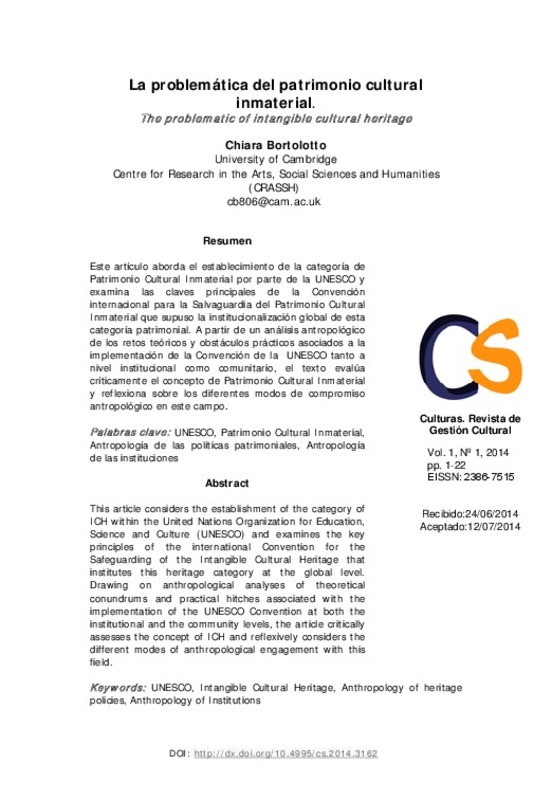BARNETT, Michael; FINNEMORE, Martha (1999), The politics, power, and pathologies of international organizations, International Organization, Vol. 53, n° 4, p. 699-732.
Robert Baron. (2010). Sins of Objectification? Agency, Mediation, and Community Cultural Self-Determination in Public Folklore and Cultural Tourism Programming. The Journal of American Folklore, 123(487), 63. doi:10.5406/jamerfolk.123.487.0063
Bendix, R. (s. f.). Héritage et patrimoine : de leurs proximités sémantiques et de leurs implications. Le patrimoine culturel immatériel, 99-121. doi:10.4000/books.editionsmsh.3559
[+]
BARNETT, Michael; FINNEMORE, Martha (1999), The politics, power, and pathologies of international organizations, International Organization, Vol. 53, n° 4, p. 699-732.
Robert Baron. (2010). Sins of Objectification? Agency, Mediation, and Community Cultural Self-Determination in Public Folklore and Cultural Tourism Programming. The Journal of American Folklore, 123(487), 63. doi:10.5406/jamerfolk.123.487.0063
Bendix, R. (s. f.). Héritage et patrimoine : de leurs proximités sémantiques et de leurs implications. Le patrimoine culturel immatériel, 99-121. doi:10.4000/books.editionsmsh.3559
BLAKE, Janet (2000), On defining the cultural heritage, International and Comparative Law Quarterly, Vol. 49, n° 1, p. 61-85.
BARTHOLEYNS, Gil & Daniel BONVOISIN, (2011), La création ludique est-elle soluble dans le patrimoine ? Culture et communauté du jeu de rôles grandeur nature », in Chiara Bortolotto (dir.), Le Patrimoine culturel immatériel. Enjeux d'une nouvelle catégorie, Paris : Éditions de la Maison des sciences de l'homme, p. 187-210.
BROWN, Michael F. (2005), Heritage trouble. Recent work on the protection of intangible cultural property, International Journal of Cultural Property, n° 12, p. 40-61.
CONSEIL DE L'EUROPE (2001), La Participation des citoyens à la vie publique au niveau local, Recommandation Rec (2001) 19 adoptée par le Comité des ministres du Conseil de l'Europe le 6 décembre 2001 et rapport explicatif. Strasbourg: Éditions du Conseil de l'Europe.
Fournier, L.-S. (s. f.). La Tarasque métamorphosée. Le patrimoine culturel immatériel, 149-166. doi:10.4000/books.editionsmsh.3565
GAMBONI, Dario (2001), World heritage: shield or target?, Conservation. The Getty Conservation Institute Newsletter, Vol. 16, n° 2, p. 5-11.
Hafstein, V. T. (s. f.). Célébrer les différences, renforcer la conformité. Le patrimoine culturel immatériel, 75-97. doi:10.4000/books.editionsmsh.3557
HALE, Charles R. (2006), Activist research v. cultural critique. Indigenous land rights and the contradictions of politically engaged anthropology, Cultural Anthropology, Vol. 21, n° 1, p. 96-120.
KIRSHENBLATT-GIMBLETT, Barbara (2000), Folklorists in public. Reflections on cultural brokerage in the United States and Germany, Journal of Folklore Research, Vol. 37, n° 1, p. 1-21.
KURIN, Richard (2007), Safeguarding Intangible Cultural Heritage. Key factors in implementing the 2003 Convention, International Journal of Intangible Heritage, Vol. 2, p. 10-20.
LOW, Setha M.; ENGLE MERRY, Merry (2010), Engaged anthropology. Diversity and dilemmas. An introduction to supplement 2, Current Anthropology, Vol. 51, n° S2, p. 203-226.
MACCHIARELLA, Ignazio (2011a), Dove il tocco di Re Mida non arriva. A proposito di proclamazioni Unesco e musica, La Ricerca Folklorica, n° 63, p. 71-80.
Maguet, F. (s. f.). L’image des communautés dans l’espace public. Le patrimoine culturel immatériel, 47-73. doi:10.4000/books.editionsmsh.3555
MARIOTTI, Luciana (2011), Patrimonio culturale immateriale: un prodotto metaculturale, La Ricerca Folklorica, n° 63, p. 19-26.
Nas, P. J. M. (2002). Masterpieces of Oral and Intangible Culture. Current Anthropology, 43(1), 139-148. doi:10.1086/338287
Noyes, D. (s. f.). La fête ou le fétiche, le geste ou la gestion. Le patrimoine culturel immatériel, 125-148. doi:10.4000/books.editionsmsh.3563
Sandroni, C. (s. f.). L’ethnomusicologue en médiateur du processus patrimonial. Le patrimoine culturel immatériel, 233-252. doi:10.4000/books.editionsmsh.3575
Torantore, J.-L. (s. f.). Du patrimoine ethnologique au patrimoine culturel immatériel : suivre la voie politique de l’immatérialité culturelle. Le patrimoine culturel immatériel, 213-232. doi:10.4000/books.editionsmsh.3573
TYLOR, Edward Burnett (1994) [1871], The Collected Works of Edward Burnett Tylor, Vol. 3-4 : Primitive Culture. Londres: Routledge.
UNESCO (1996), Our creative diversity. Report of the World Commission on Culture and Development. Paris: Unesco.
[-]








